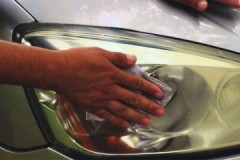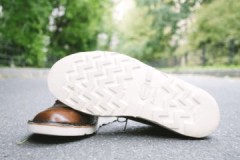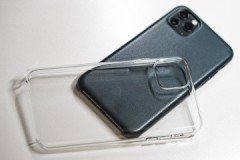Secrets of experienced craftsmen on how to remove yellow stains on the ceiling after flooding
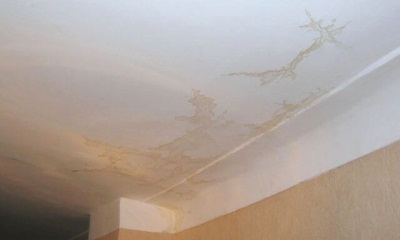 Yellow stains on the ceiling are the result of flooding, they not only spoil the interior of the room, but also, if untimely processing, become a breeding ground for fungus and mold.
Yellow stains on the ceiling are the result of flooding, they not only spoil the interior of the room, but also, if untimely processing, become a breeding ground for fungus and mold.
It is necessary to start removing yellow spots after the flood as soon as possible. The main thing is to study in advance the subtleties and features of the process for different types of surfaces.
If you have a leaking ceiling and want to know how to remove yellow stains after flooding, read this article.
Content
Eliminate yellowness
Before proceeding with the elimination of the traces of the flood on the ceiling, it is necessary first of all to assess the scale of the disaster. The choice of upcoming works depends on this.
Painting or whitewashing
The easiest way to remove flood marks on the ceiling is to paint over or whitewash yellow stains.
In order for a new layer of paint to lay flat, certain rules must be followed:
-
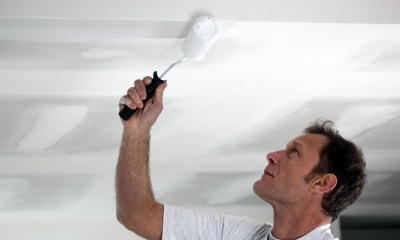 Surface preparation. To do this, carefully clean off the old layer of decorative coating.
Surface preparation. To do this, carefully clean off the old layer of decorative coating.In order for the whitewash not to crumble, but to be removed in a whole layer, the places of smudges are treated with an adhesive composition of brewed flour (for 6 liters, you need to take 3 tablespoons of flour).
- Ceiling primer. This simple rule provides the best adhesion of the fresh whitewash to the worm surface.
- We apply water-based paint or lime composition. It is better to choose a new paint that is thick and dense in consistency so that yellow streaks do not appear on the freshly painted surface of the ceiling.
The staining method is effective if the flood area is small, the plaster layer is not destroyed by water.
Chemical treatment
Minor traces of the flood on the ceiling can be removed using chlorine-based treatment.
How it's done:
- The place of the flood is carefully cleaned with a wide metal spatula.
- Whiteness (as an option, you can use bleach, toilet cleaner) is poured into a glass container.
- Protecting your hands with rubber gloves, a soft sponge is moistened in a chlorine-containing agent, after which it is applied to the yellow spot.Thus, gently blotting, the entire surface of the yellow stains is processed. After the whiteness dries, the macula will begin to lighten. Processing is carried out several times, until the traces of the flood are completely eliminated.
- The entire surface of the ceiling is covered with a fresh layer of whitewash or paint.
Mechanical cleaning
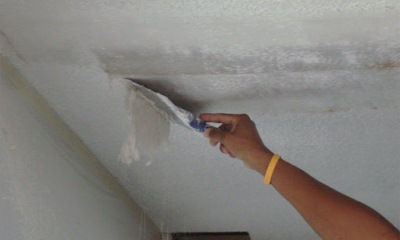 The most common way to remove yellow flood spots on the ceiling is mechanical cleaning:
The most common way to remove yellow flood spots on the ceiling is mechanical cleaning:
- the traces of the flood are carefully cleaned with a metal spatula;
- if necessary, the cleaned surface is covered with a thin layer of finishing putty;
- the prepared ceiling is primed and covered with a layer of paint or whitewash.
Before applying paint, the primer coat must dry well. Otherwise, there are great risks of delamination of materials applied to the ceiling.
Overhaul
In the case when the water destroyed not only the upper decorative layer, but also touched a deeper layer of plaster, it will be possible to restore the original appearance of the ceiling only by overhaul.
The end result of the work directly depends on adherence to a clear sequence of actions:
- Old paint and a layer of damp plaster are removed from the damp surface with a spatula. It is convenient to carry out preparatory work using a wide spatula. If in the process of stripping exposed reinforcement was opened, it is also cleaned, covered with two layers of paint.
- After waiting for a while (the cleaned surface must dry), the rough ceiling is treated with a deep penetration primer. This will help to degrease the surface and prepare them for the next reapplication.
- A finishing putty is applied to the prepared surface, the layer is leveled and left until the material is completely set to the surface.
- The dried layer of plaster is cleaned with sandpaper and covered with a primer.
- Using a roller or brush, the ceiling is covered with whitewash or paint.
Rules for removing yellow stains for different types of ceiling structures
When choosing a method to eliminate the traces of a flood, a special approach is required:
- tension,
- glossy,
- fabric,
- plasterboard ceiling structures.
For each type of ceiling, there are certain repair rules that should be followed in order to restore surfaces as quickly and efficiently as possible.
Stretch
To eliminate the traces of the flood on the stretch ceiling, act according to the following algorithm:
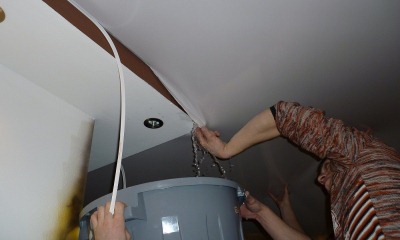 Take out the staples that fix the tensioning fabric from the corner as close as possible to the place of leakage.
Take out the staples that fix the tensioning fabric from the corner as close as possible to the place of leakage.- Bending back the canvas, the accumulated water is drained.
- They clean the softened layers of plaster of the rough concrete base (work must be carried out as carefully as possible so as not to damage the tension cloth)
- The cleaned surface is dried with a construction hairdryer, after which the stretch fabric is fixed with brackets to its original place.
It is strictly forbidden to pierce the stretch ceilings in order to drain the accumulated water. Under pressure, a small puncture expands, turns into a huge hole, which cannot be repaired.
Plasterboard
It is easy to return the original appearance of the plasterboard ceiling, the main thing is observe a clear sequence of actions:
- using a sharp knife or screwdriver, pierce a sheet of drywall, drain the accumulated water;
- expanding the puncture site, determine the degree of damage;
- if the water leak did not have time to significantly deform the ceiling covering (the drywall did not swell, a loud knock is heard when tapping), then, after drying the leak, the hole is covered with a layer of plaster, primed and covered with whitewash again.
Glossy
It is easiest to clean glossy surfaces from yellow streaks after a flood.... After the water is drained from the interceiling space, the glossy film is mounted in its original place, and the traces of the flood are wiped with a sponge dipped in an alcohol solution (2 tablespoons of alcohol are enough per liter of water).
When cleaning glossy stretch seals, do not use hard brushes and sponges that contain chlorine, alkali or acid. The result of such cleaning will be a permanently damaged surface.
Tissue
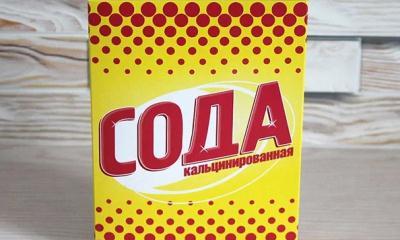 Slight flood marks on the fabric surface of the ceiling will help remove wet cleaning using soda ash.
Slight flood marks on the fabric surface of the ceiling will help remove wet cleaning using soda ash.
It is enough to dilute the soda to the state of a thick slurry with clean water and apply the resulting product to the yellow traces of the flood.
After the soda gruel dries, it is washed off with warm water, and the fabric ceiling is wiped dry with a soft cloth.
If, after cleaning, the traces of the flood have not disappeared, the entire surface of the stretch fabric covering is painted with water dispersion paint.
Advice
A few secrets of experienced craftsmen will help carry out work to eliminate yellow stains on the ceiling quickly and efficiently:
- Before starting any work to eliminate traces of flooding, you must make sure that the electricity supply to the meter is shut off.
- Before proceeding to eliminate the traces of the flood, it is necessary to carefully tap the entire surface of the ceiling with a rubber hammer. This will help diagnose hidden areas of detachment of the whitewash from the rough surface.
- It is necessary to clean the ceiling after the flood as soon as possible. While paint and plaster are damp, they can be easily removed in solid strips. It is much more difficult to clean up dried out traces of a flood.
- Instead of chemical industrial products, you can whiten yellow spots with a self-made composition. To do this, mix one part of concentrated citric acid and two parts of crushed chalk. Glycerin is added to the resulting mixture (you should get a thick slurry). The resulting composition is applied to yellow stains and left for sixty minutes, after which the stains are washed off with clean water.
The most complete and useful information on methods and means of removing yellow spots and yellowness from various surfaces and products is presented in this section.
Related videos
How to remove yellow streaks on the ceiling (and not only) after flooding, the video will tell you:
Conclusion
Strict adherence to all the rules for removing yellow stains on the ceiling after the flood will help to return the surface to its original appearance as quickly as possible.

